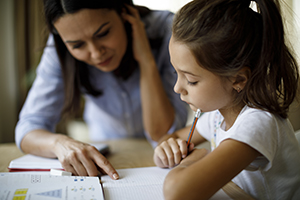Making the Grade From Home
During the Stay at Home order, distance learning has become the norm for families across the country. From preschool to high school and beyond, creating a good study environment at home can be a challenge. Here are some tips to help set your kids up for success during this time.
1. Create a study space
- Prepare a space where your child can do his or her best to focus. For some youth that may mean being apart from others, whereas others may want a caregiver close to help stay on task.
- Try to have the study space as organized as possible.
- If your child is working in his or her room, it is best to make the bed and have a very clean room. Then move to a desk or other space in the room to work.
2. Make a schedule
- Create a routine around study time. Put in the times that your child has to “check-in” or “check-out” with instructors.
- Include time in one's schedule for different courses. Schedule in some time to have a snack or have a movement break. But set timers for breaks to help get back on track when needed.
3. Reward your child for hard work
- Consider doing a challenging task first and then rewarding your child with an easy or more enjoyable task.
- Give your child a snack or treat for NOT procrastinating and for sticking with the schedule. Consider rewarding him or her with a quick game or video chat with a friend, a walk or an activity with a family member.
4. Make sure to take some breaks from the screen
- We are spending more and more time on screens than ever before. Remember to give your eyes a break.
- Schedule some “screen free” time. Ideas for this time include: playing a board game or cards, building Legos or a fort, taking a walk, riding a bike, cooking or baking, reading a book, drawing, writing a letter or making a card for a friend, playing an instrument or singing.
- Find creative and fun ways to use this time to take care of yourself and others around you. Be mindful of how you spend your time.
5. Experiment and learn what works best for you and your family
- Try something and see how it goes. Observe how everyone in the family is doing and talk about what is and isn't working. Consider having more regular family meetings and take time for family meals.
- Families are encouraged to be easy on themselves. This is new for everyone and we are all doing our best. Find routines that work for your family and be open to changing things when they aren't working anymore.
